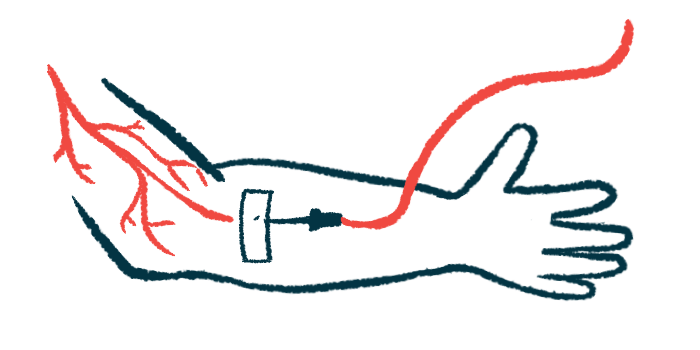Reslizumab successfully treats case of NEAE after COVID-19 vaccination
Rare angiodema found in woman, 70, after 3rd vaccine dose

A 70-year-old woman diagnosed with non-episodic angioedema associated with eosinophilia (NEAE) — high levels of immune eosinophil cells — was successfully treated with reslizumab, a medication normally used to treat asthma associated with eosinophilia, according to a case report.
Her symptoms had started after receiving a third COVID-19 vaccine dose. These and blood eosinophilia eased after steroid therapy, but the woman failed to respond to steroid dosage reduction.
However, the patient remained symptom-free with normal eosinophil cell counts during eight months of reslizumab treatment without steroids.
“Although it was not perfect, a thorough evaluation was conducted for this patient,” the study author wrote, adding that “reslizumab would be a treatment option for patients with [angioedema with eosinophilia] who are refractory [resistant] to systemic steroid therapy.”
Her treatment was detailed in a case study, “Non-episodic angioedema with eosinophilia after COVID-19 vaccination: a case successfully treated with reslizumab,” published in the journal Allergy, Asthma & Clinical Immunology.
Reslizumab treats woman with NEAE with resistance to steroids
Angioedema with eosinophilia (AE) is a subtype of angioedema associated with elevated levels of eosinophils, a type of white blood cell typically responsible for fighting off bacteria, viruses, parasites and other infectious agents. The condition can be classified as episodic or non-episodic.
It also is characterized by angioedema or swelling of the deeper layers of the skin, as well as an itchy rash on the skin known as urticaria, fever, and weight gain.
Cytokines — small proteins crucial in controlling the growth and activity of other immune cells and blood cells — produced by active immune T-cells, mainly interleukin-5 (IL-5) — “may be involved in the activation of blood and tissue eosinophils that drive AE,” the researcher wrote.
Thus, anti-IL-5 therapies, such as reslizumab (sold under the brand name Cinqair in the U.S. and Cinqaero in the European Union), are indicated for the treatment of eosinophilic diseases.
Various adverse reactions to COVID-19 vaccines have been reported, with eosinophil responses having been observed during virus infection and vaccination. But, “whether eosinophils have a protective or exacerbating role during COVID-19 remains unclear,” the author wrote.
Here, a researcher in Korea described the case of an elderly woman presenting who developed generalized swelling (edema) and urticaria five days after receiving a first dose of the Moderna vaccine — the third in her COVID-19 vaccination scheme.
She first developed edema in the left upper arm, where the vaccine was administered. Swelling then spread to both arms and legs and the trunk — the chest, abdomen, pelvis, and back — especially on the left side. She also gained 10 kg (22 pounds), and the itchy skin rash appeared on both arms and legs.
Laboratory tests showed elevated eosinophil counts, of 3,212 cells per microliter of blood, which increased to 18,125. The normal range is below 500 cells per microliter of blood.
The patient received methylprednisolone (1 mg/kg/day), an intravenous steroid used to relieve inflammation, for seven days. Her urticaria resolved rapidly, while angioedema gradually eased until it disappeared completely.
She also received prednisolone, an oral steroid, which was slowly tapered off over the course of five weeks. Her eosinophil blood counts became normal, but seven days after stopping treatment, they rose again (2,528 cells per microliter of blood), and angioedema in the face and arms reappeared.
Prednisolone was restarted, and its dose decreased over the course of four weeks (from 30 to 5 mg/day). On the fifth day of maintaining a 5 mg/day dose, she developed swelling in the larynx (voice box), and her eosinophil cell count went up to 7,248 cells per microliter of blood.
Reslizumab was then introduced. It was injected every four weeks (200 mg) along with prednisolone for the first 14 days (30 mg/day for seven days and 20 for the next seven days).
At the third injection, the dose of reslizumab was reduced to 100 mg and maintained for the next four weeks. The sixth infusion was given after an eight-week interval.
The woman’s symptoms resolved and eosinophil counts remained within the normal range during the eight months of treatment with reslizumab without steroids.
Reslizumab would be a treatment option for patients with [angioedema with eosinophilia] who are refractory [resistant] to systemic steroid therapy.
To date, only one case of AE following COVID-19 vaccination has been reported. In that case, a patient developed NEAE after a second dose of the Pfizer-BioNTech vaccine and was effectively treated with steroids.
“Many conditions can cause eosinophilia, and a comprehensive approach is needed for an accurate diagnosis,” the researcher wrote.
The clinician noted that “a comprehensive approach is needed for an accurate diagnosis” of angioedema with eosinophilia.
“The diagnostic criteria for AE is not yet well defined, it remains one of exclusion,” the researcher wrote.







